Your first DSP module with Vitis HLS
Have you ever wondered how you can speed up the process to get running your custom DSP module in hardware ASAP? Implementing even the simplest DSP in hardware using plain HDL is not very intuitive. Particularly, if you are not familiar with hardware design. Interfaces, synchronism and data types are some of the concepts that you have to take care of. Along with hardware design concepts (clocks, registers, flip-flops) and toolsets (Vivado, Vitis, HLS). It takes too much effort and then… you give up.
Let’s say that there is still hope. We present a “new” tool that has been out there for a long time but still unknown for most people. Yet it helps to abstract from the complexity mentioned above. We offer a remarkably simple step-by-step guide to kick off your first DSP module in Vitis HLS. The uncomplicated way, of course!
In this blog post you will find tips, common errors and useful information that will work wonders for you! If you already know some of the concepts that we present here, reviewing them will not make it any worse. But if it’s the first time that you hear about HLS, we hope it can ease your journey getting started with it.
Introduction
Vitis HLS is a High-Level Synthesis (HLS) tool developed by Xilinx to easily create complex FPGA algorithms using C/C++. This means that instead of coding the module using a HDL, you describe the hardware structure with C/C++ code. The code will be ultimately mapped to FPGA resources, not a normal processor (CPU). Thus, keep in mind at every moment that you are describing a hardware circuit not a software program. There are four main steps involved in this process of converting the C/C++ code into a HDL (Verilog or VHDL):
- C Simulation (optional). It validates the function to be synthesized with a testbench. This testbench must include a main() function which also must contain a call to the hardware function. The basic functionality of this testbench should include a function to feed the input of the module, a call to the module itself and finally a reading function to read the outputs generated by the hardware function. It is highly recommended to create a self-checking testbench which, in addition, compare this generated outputs with golden values or a software reference model. In this way, no manual interaction is needed to test if the results continue to be correct after a change in the code. Although this step in the workflow can be bypassed, we advise to spend quite amount of time simulating before synthesizing. It will save you headaches, preventing you unnecessary debugging in hardware!
- Synthesis. In this step, Vitis HLS takes the top-level function (the function to be synthesized) written in C/C++ and then synthesized it into an RTL implementation. It consists of two major processes: Scheduling and Binding:
- Scheduling: It determines when every operation must be performed. There are some operations that must be completed before other can start.
- Binding: Allocate resources for the operations determined in the previous step.
NOTE!
The C Simulation takes both the top-level function and the testbench. The Synthesis just takes the function to be synthesized (the top-level function).
3. Co-simulation (optional). If you have decided to add a C testbench to the project for simulation purposes (step 1) then you can use this step. The purpose is to verify that the RTL generated in the previous step performs the same functionality as the C source code.
4. Export RTL. The last step in the Vitis HLS flow is to export the RTL design. This will generate a .zip file which contains all the information (hdl code, constraints, drivers…) of your hardware module. This information can be used in other tools. For instance, you can use Vivado to instantiate the IP into the block design or you can use directly the HDL code generated in your design.
To illustrate all these steps in a clear and straightforward manner, we are going to create a very simple function which calculates the power of 2 of a complex number. This function called complex_power2() can be expressed mathematically as follows:
(a+bi)^2 = a^2 + (bi)^2 + 2abi = (a^2 - b^2) + (2ab)i
Getting Started with Vitis HLS 2021.2
Create new Vitis HLS Project
- Open Vitis HLS 2021.2
- File > New project. Specify the project name and the location.
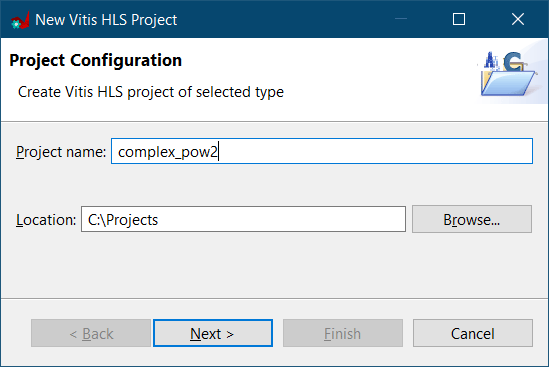
TIP!
Select carefully the location. The maximum length for a path is 260 characters on Windows OS. Therefore, it is highly recommended to select one as near as possible to C:/ to avoid potential issues.
3. Add the top function name and the design files. The top function name represents the name of the function that we desire to implement in hardware. The design files are the files which contains the code (both declaration and definition) of the function.

TIP!
Naming the top function and the design file the same is highly recommended. It increases the readability and structure of your code.
4. Create a new testbench file. Adding ‘_tb‘ to the name of the file will clearly identify that this file contains the simulation code. This is a very standard way to visually separate files which contain simulation code from those that contain the implementation itself.
5. Configure your solution. A solution in HLS represents a particular implementation of the C/C++ code that we just added. Implementations vary in different aspects, for instance, the clock frequency or the part selection.
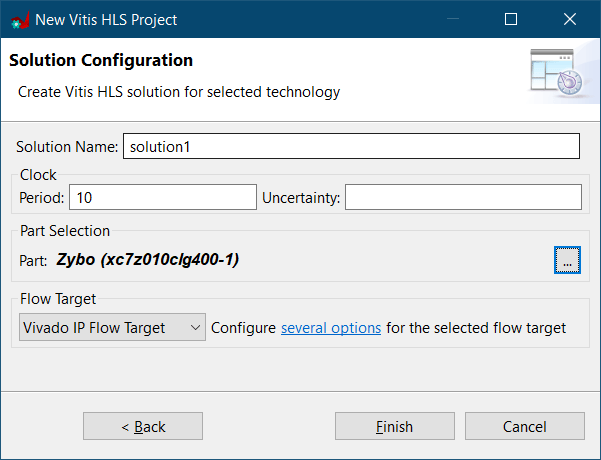
STAY TUNNED!
6. Finally, check under the Explorer window that both the design files and the testbench were successfully added to the project.
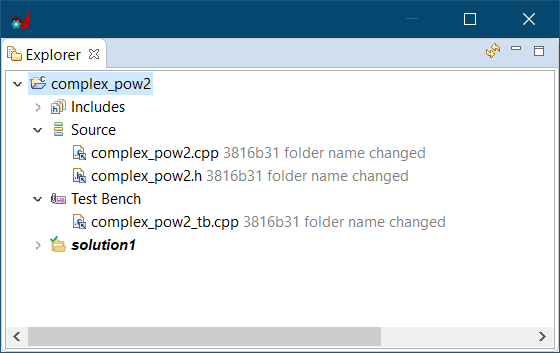
Modifying the Design Files and the Testbench
Design Files
The design files are files which contain C/C++ source code. The primary extension of these files are .c for C code and .cpp for C++. Includes which contain the declaration are also possible (extension .h). You can add multiple design files to your project but for the sake of simplicity, we added just one design file (complex_pow2.cpp) with its declaration (complex_pow2.h). Note that in the case that you have multiple design files, just one must be defined at the top-level function. You cannot define multiple top-level functions at the same time but you can select which top-function you want to synthesize at a given moment.
The design file has a main purpose: define very precisely the functionality of our function to be synthesized. As stated in the beginning of the blog-post, our functionality is based in the computation of the power of 2 of a complex number:
(a+bi)^2 = a^2 + (bi)^2 + 2abi = (a^2 - b^2) + (2ab)i
Therefore, given the real (a) and imaginary (b) part of a complex number, the output real and imaginary result must be:
RE = a^2 - b^2
IM = 2ab

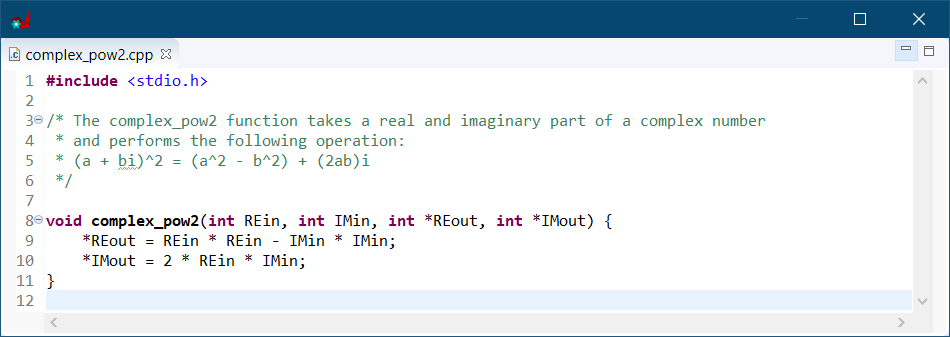
- REin and IMin are the real and imaginary part respectively of the input complex number. These arguments represent the inputs of our module.
- REout and IMout are the real and imaginary part respectively of the output complex number. These arguments represent the outputs of our module. Call by reference (argument pointers) is used to be able to return more than one variable in the function.
Testbench
In the previous step, we wrote the C/C++ code that we think it describes the intended functionality. But, are we 100% percent that it is correct? Well, the testbench will definitely solve our doubts!
The main idea behind a testbench is compare two sets of data:
- A set of data that we are 100% sure it is correct. It can be either golden values or the values generated from a software reference model. In this example, we decided to create a software reference model because its simplicity. With more complex designs another approach could be generate golden values using other tools such as MATLAB or Octave. The software reference model represents the “software” version of our hardware function and it will generate the correct values. It means, the values that properly represent the intended functionality of our design. The software reference model has been called sw_complex_pow2().
- A set of data generated by our hardware function – complex_pow2(). This values are the ones generated by the top-level function.
Our testbench is divided in three main parts:
- Calculate the output values using the software reference model.
- Calculate the hardware output values using the hardware function.
- Compare both values and check if they are the same.
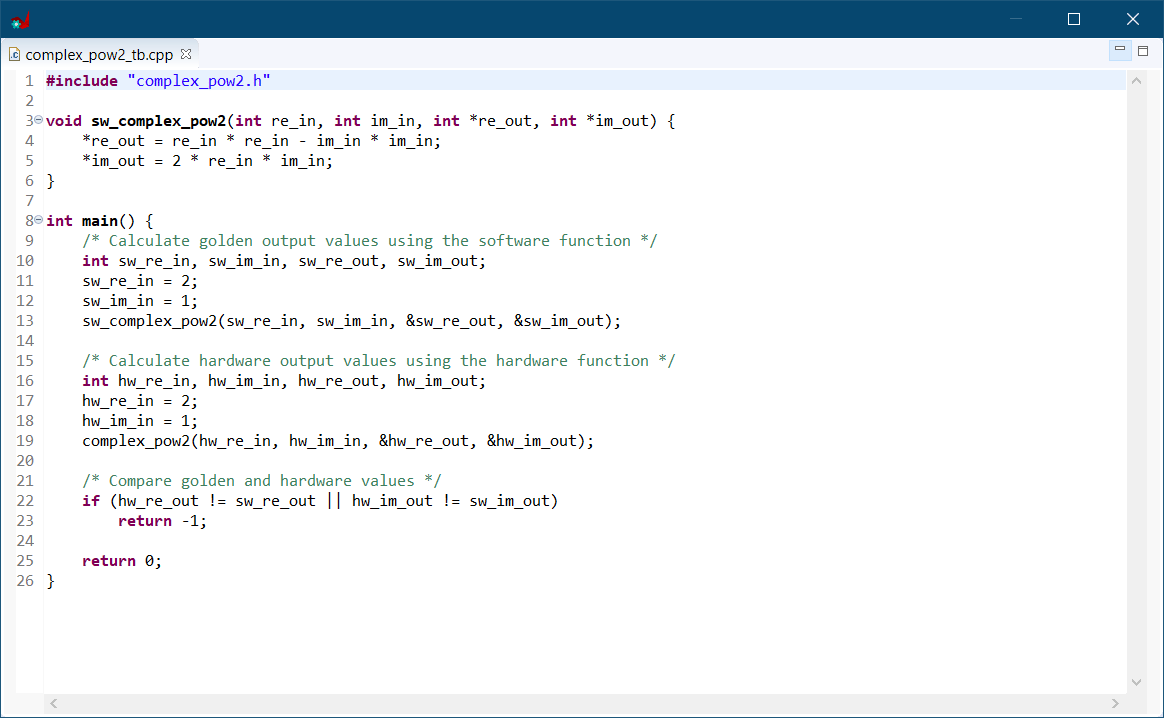
Run C Simulation
The C simulation is the first step in the Vitis HLS flow. This step takes the C/C++ source code of your testbench and it will compile, link and execute it. Therefore, it will check if the code is successfully builded and if the functionality implemented is the one intended at the beginning.
To execute this step, click in the following button inside the Flow Navigator window:
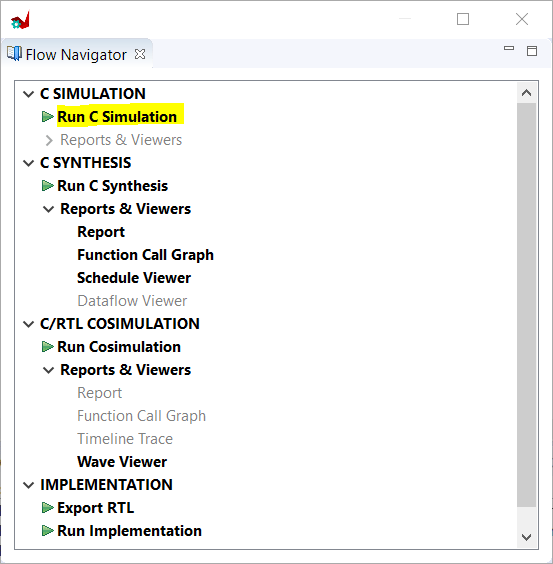
After completion, a log file is generated which contains the output from the C Simulation:

The complex_pow2_csim.log shows the output generated from the C Simulation. The compiler used for the simulation is GCC. An executable file (csim.exe) was generated from the result of the build process. After running the executable, we can check that it has finished successfully.
Run C Synthesis
The C Synthesis step takes care of translating the C/C++ source code into an RTL implementation. Therefore, the input are C/C++ files and the generated files from this step are HDL (Verilog/VHDL).
It is important to note here that the tool will use just the top-level function (complex_pow2.cpp) but not the testbench (complex_pow2_tb.cpp). Therefore, all the non-synthesizable code must be in the testbench and all the synthesizable code in the top-level function.
STAY TUNNED!
In future blog posts we will cover the differences between synthesizable and non-synthesizable code. This is a very important topic because the use of non-synthesizable code in your hardware function will lead to an impossible implementation in your FPGA!

The C Synthesis is applied to a specific solution. You can have multiple implementations (solutions) of the same C/C++ source code. However, you can just synthesize one at a time.
NOTE!
HLS Pragmas takes effect in this step and they will drive the tool to infer the hardware in a specific way. We did not use them in this example for simplicity, but definitely we will use them in future posts!
Select the specific period (ns) and the board part. We have configured to run our design at 100 MHz (10 ns) and our target board is the Zybo.

After the synthesis has been completed, there are multiple hardware-related information available. For instance, timing estimation, performance and resource usage:
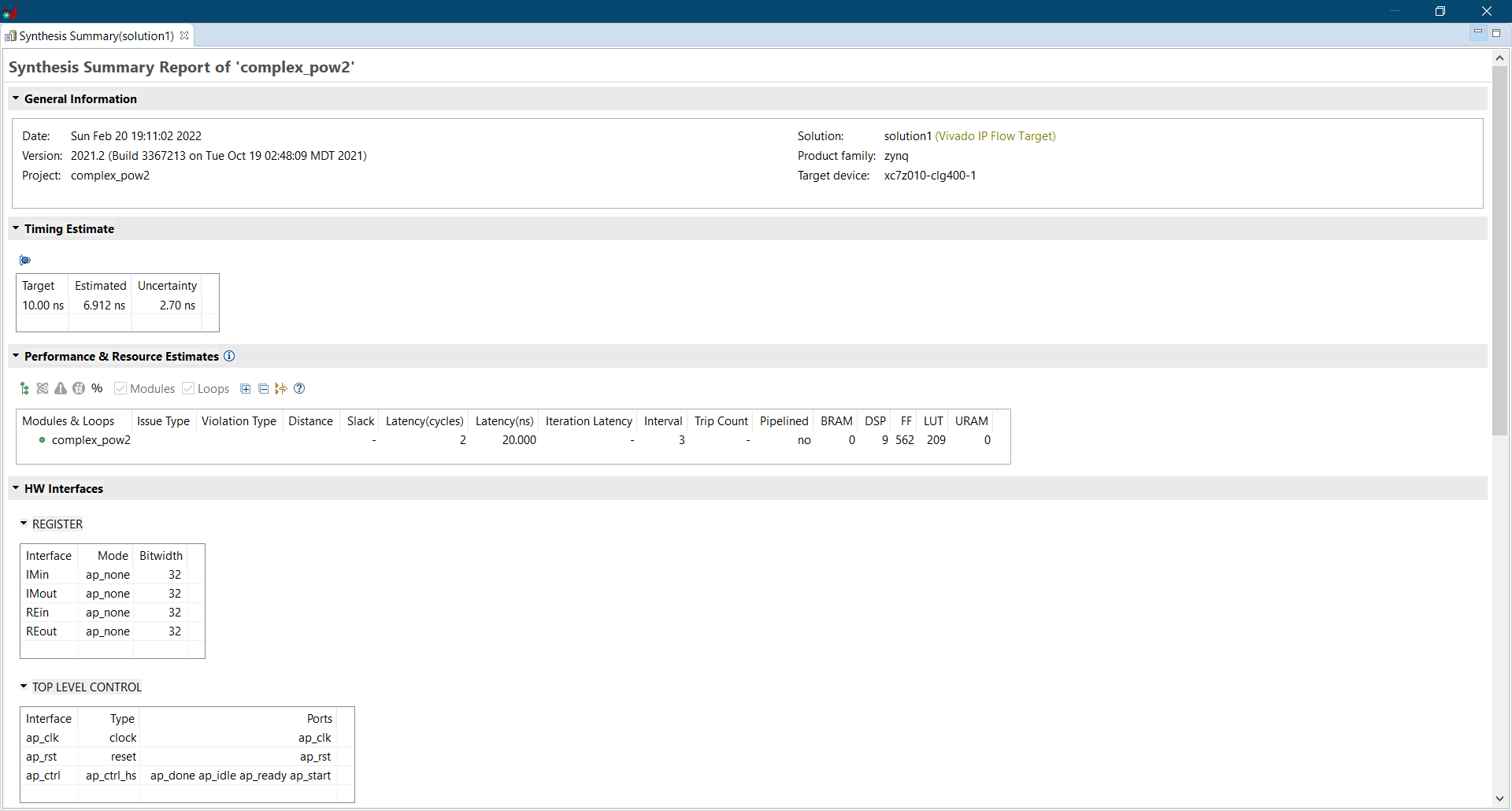
Timing Estimate
The active solution was configured to run at 100 MHz which represents the target frequency. However, the tool was able to achieve an estimated clock frequency of 144 MHz. The clock uncertainty was automatically set by the tool because we did not specified any value in the configuration. The clock uncertainty is the margin used by the tool for other processes like place and route. Note that if the estimated clock frequency plus the clock uncertainty are greater than the target frequency, then a timing violation is issued.
Performance & Resources Estimates
This is the section where we can see clearly that the operations performed in our C/C++ code are mapped into hardware resources of our target FPGA. This mapping will depend on multiple factors, for instance:
- How our code is written.
- Pragmas used.
- Target platform.
From the report we can check that in our case the resources used are:
- 0 BRAM
- 9 DSP
- 562 Flip-flops
- 209 LUT
- 0 URAM
In addition to the hardware resources used, there are more information that can be extracted. For instance, if the function has been pipelined, the throughput (interval) and the latency.
HW Interfaces
The HW interfaces were mapped as:
- Two 32-bit data input ports (REin, IMin),
- Two 32-bit data output ports (REout, IMout).
WARNING!
The bitwidth of this ports are calculated depending the data type used in the C/C++ code. Those ports were defined as integer types and therefore were implemented as 32 bits each one. It means that the maximum value that we can represent is (2^31 – 1). It is important to keep in mind to avoid overflows due to the operations performed between the variables.
The are additional interfaces that are needed to run the hardware module. Those interfaces are ap_clk and ap_rst which represent the clock and the reset of the module respectively.
There is an additional interface (ap_ctrl) added also automatically by the tool and it is the default top level protocol for the return port of our function.
Run Co-simulation
The C/RTL Co-simulation will compare both the software implementation (C Simulation step) and the hardware implementation (C Synthesis step) and it will check if the same results are achieved. In this way, the tool can check that the synthesis of the function was properly done and its results are the same as the software reference model.


In the C/RTL Co-simulation window, select Vivado XSIM as RTL simulator. Select Verilog to have access to the full features of Vitis HLS. If you select VHDL, you will not have access to some of them, for instance, the wave viewer or the timeline trace.
Select Dump Trace “all” to activate the wave viewer. This will record all the signals in our design to be able to visualize them after co-simulation.
The extra options are quite interesting when using the DATAFLOW pragma. In our case, we left them unchecked.
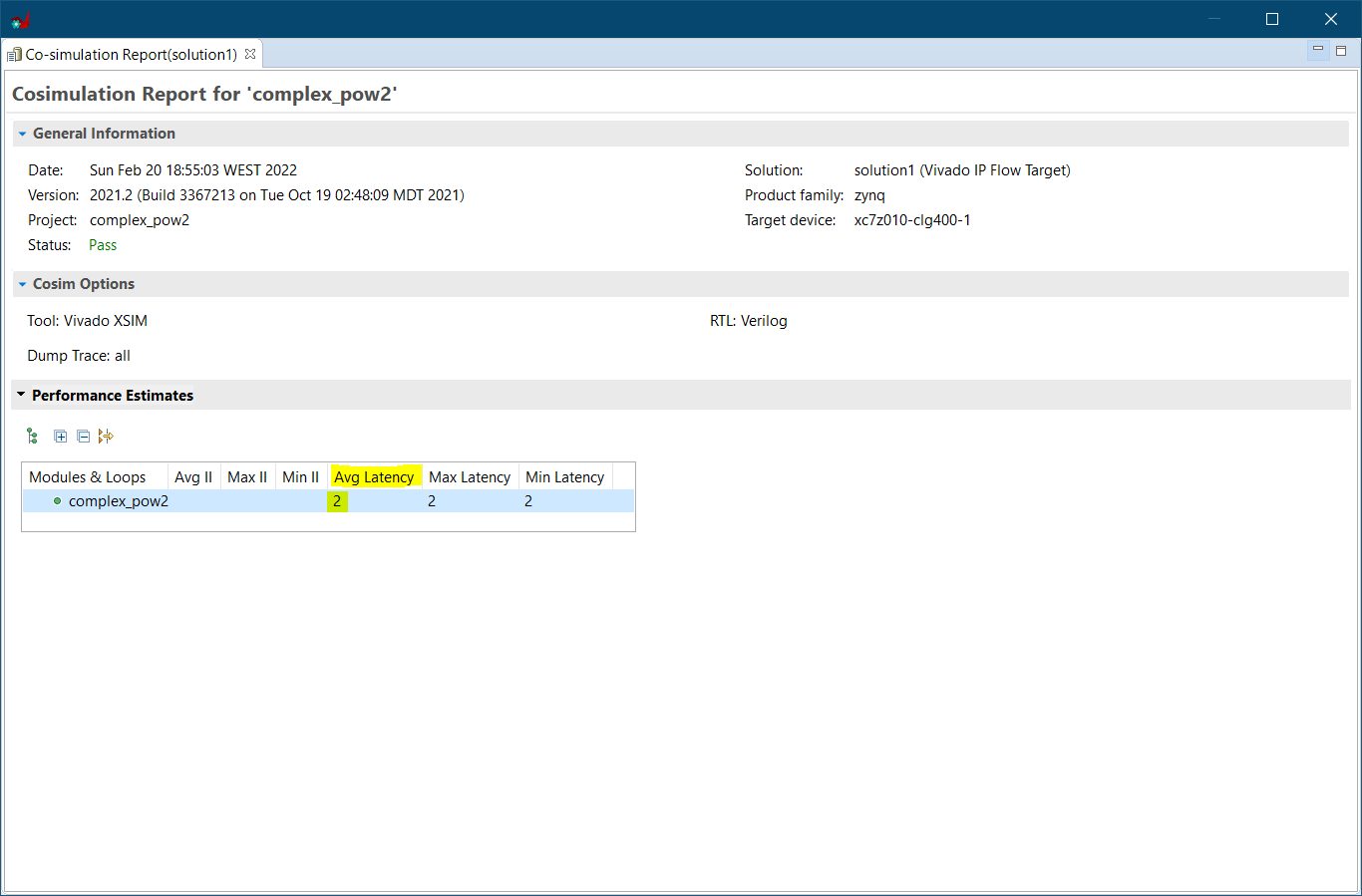
The Co-simulation has been successfully completed. A new report is available, showing some performance estimations. The latency of our module is 2, which means the number of clock cycles that our module needs to complete its operations since a new input was feed.
A waveform is also available. Click in Wave Viewer under the C/RTL Simulation field.


The inputs of our design, REin and IMin, are set at the same time to 0x2 and 0x1 respectively. Then, after one clock cycle, the imaginary part (IMout) is available but the real part (REout) is available two clock cycles after. The operations performed in the IMout and REout are not the same and the way the tool schedules them will determine its latency.
STAY TUNNED!
In future blog-posts, we will delve into the Schedule Viewer to understand better how to analyze the scheduling process done by the tool.
Export RTL
Exporting the RTL design is the final step in the Vitis HLS flow. This will package the module into a .zip to be used as an IP. You can configure some parameters of this IP such as vendor, version and description:
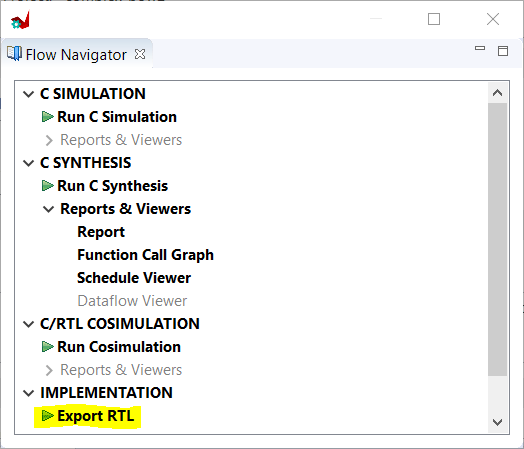
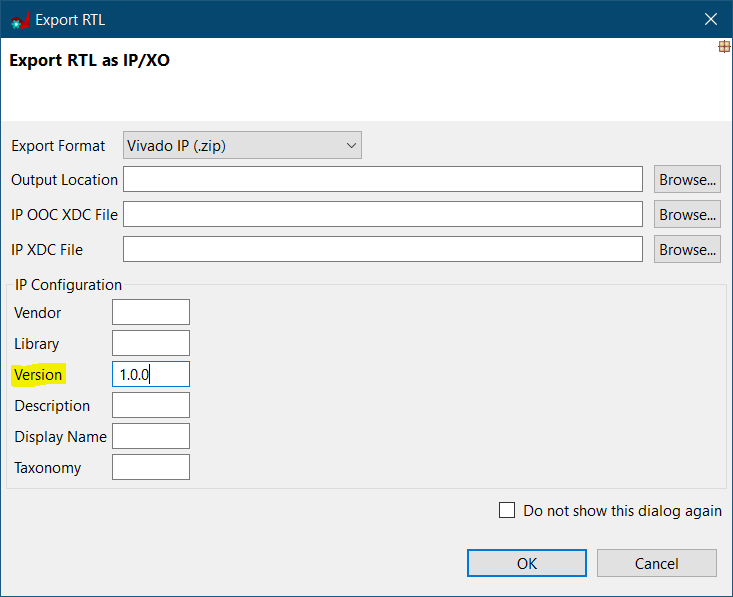
BUG!
Do not let the version field empty. Set it to a number to avoid number overflow after new year 2022. Click here to know more about it
Conclusion
In this step-by-step guide we covered the basic workflow to kick-off your first project using Vitis HLS. We hope you enjoyed this guide and we would love to hear from you: what works, what doesn’t? was it useful?
It was a briefly introduction without much deep in any specific aspect. So, did we leave anything out? Of course! Let us know your interests, it will help us know how we can add more value to these blog-posts and help you even more.




